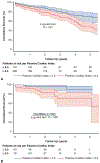Preoperative passive venous pressure-driven cardiac function determines left ventricular assist device outcomes
- PMID: 37495169
- PMCID: PMC10805966
- DOI: 10.1016/j.jtcvs.2023.07.019
Preoperative passive venous pressure-driven cardiac function determines left ventricular assist device outcomes
Abstract
Background: Right heart output in heart failure can be compensated through increasing systemic venous pressure. We determined whether the magnitude of this "passive cardiac output" can predict LVAD outcomes.
Methods: This was a retrospective review of 383 patients who received a continuous-flow LVAD at the University of Michigan between 2012 and 2021. Pre-LVAD cardiac output driven by venous pressure was determined by dividing right atrial pressure by mean pulmonary artery pressure, multiplied by total cardiac output. Normalization to body surface area led to the passive cardiac index (PasCI). The Youden J statistic was used to identify the PasCI threshold, which predicted LVAD death by 2 years.
Results: Increased preoperative PasCI was associated with reduced survival (hazard ratio [HR], 2.27; P < .01), and increased risk of right ventricular failure (RVF) (HR, 3.46; P = .04). Youden analysis showed that a preoperative PasCI ≥0.5 (n = 226) predicted LVAD death (P = .10). Patients with PasCI ≥0.5 had poorer survival (P = .02), with a trend toward more heart failure readmission days (mean, 45.09 ± 67.64 vs 35.13 ± 45.02 days; P = .084) and increased gastrointestinal bleeding (29.2% vs 20.4%; P = .052). Additionally, of the 97 patients who experienced readmissions for heart failure, those with pre-LVAD implantation PasCI ≥0.5 were more likely to have more than 1 readmission (P = .05).
Conclusions: Although right heart output can be augmented by raising venous pressure, this negatively impacts end-organ function and increases heart failure readmission days. Patients with a pre-LVAD PasCI ≥0.5 have worse post-LVAD survival and increased RVF. Using the PasCI metric in isolation or incorporated into a predictive model may improve the management of LVAD candidates with RV dysfunction.
Keywords: Fontan; Youden J statistic; clinical outcomes; echocardiography; left ventricular assist device; right ventricular assist device; right ventricular failure.
Copyright © 2023 The American Association for Thoracic Surgery. All rights reserved.
Conflict of interest statement
Conflict of Interest Statement
The authors reported no conflicts of interest.
The
Figures


References
-
- Kormos RL, Teuteberg JJ, Pagani FD, Russell SD, John R, Miller LW, et al. Right ventricular failure in patients with the HeartMate II continuous-flow left ventricular assist device: incidence, risk factors, and effect on outcomes. J Thorac Cardiovasc Surg. 2010;139:1316–24. 10.1016/j.jtcvs.2009.11.020 - DOI - PubMed
-
- Kato TS, Farr M, Schulze PC, Maurer M, Shahzad K, Iwata S, et al. Usefulness of two-dimensional echocardiographic parameters of the left side of the heart to predict right ventricular failure after left ventricular assist device implantation. Am J Cardiol. 2012;109:246–51. 10.1016/j.amjcard.2011.08.040 - DOI - PubMed
-
- Slaughter MS, Pagani FD, McGee EC, Birks EJ, Cotts WG, Gregoric I, et al. HeartWare ventricular assist system for bridge to transplant: combined results of the bridge to transplant and continued access protocol trial. J Heart Lung Transplant. 2013;32:675–83. 10.1016/j.healun.2013.04.004 - DOI - PubMed
-
- Vivo RP, Cordero-Reyes AM, Qamar U, Garikipati S, Trevino AR, Aldeiri M, et al. Increased right-to-left ventricle diameter ratio is a strong predictor of right ventricular failure after left ventricular assist device. J Heart Lung Transplant. 2013;32:792–9. 10.1016/j.healun.2013.05.016 - DOI - PubMed
MeSH terms
Grants and funding
LinkOut - more resources
Full Text Sources
Medical

